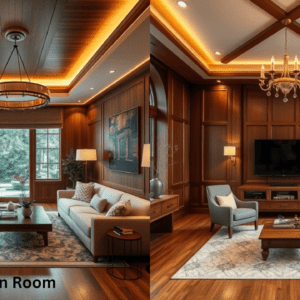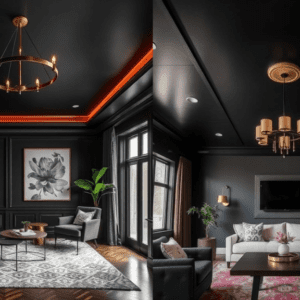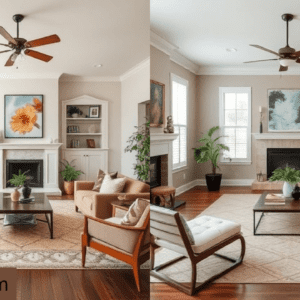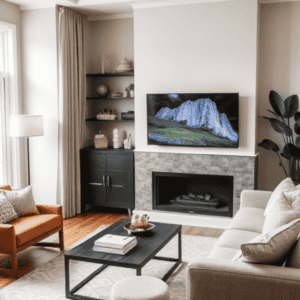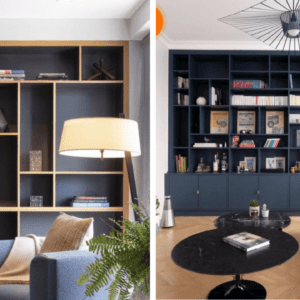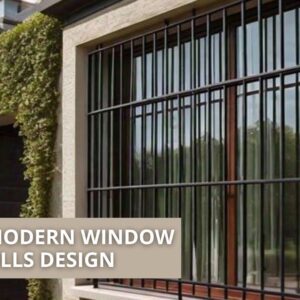
Even though ceiling design is often considered to be a forgotten detail in interior design, it is in fact quite important in terms of elegance and utility within the room. For ages, ceiling structures were deemed to be no more than a framing component, but in the past few years, they emerged as an area for originality, invention, and design experimentation. Such ambient ceiling designs are revolutionizing the atmosphere of the indoor, outdoor, and working environments, making those aesthetically appealing and cool places. This article focuses on current tendencies in designing ceilings and how this functional and decorative detail can affect the appearance of the space.
1. The Evolution of Ceiling Design

1.1 Historical Context
Ceilings have historically provided a means of decoration, primarily in large projects such as churches, palaces, and administration offices. Cavity plaster and latched and beamed ceilings were the features of European architectural styles, while Eastern architectural decor included beams and custom-made tile designs. After a fizz and a subsequent and painless cloud of resentments, the ceiling design also suffered what is called design stupefaction and in due course became a flat, monotonous, and utilitarian attribute.
1.2 Modern Revival
In the last few years, there has been an increased interest in ceiling design and decor particularly to meet the demand of individualistic spaces. These days, ceilings are not just the usual lined white bare ceilings, all sorts of materials, designs, or colors, or even lighting options are being adopted in modern ceiling designs. All these improvements in the design of the cubical rooms not only make the rooms beautiful, but they also serve many purposes to the rooms
2. Key Trends in New Ceiling Designs
2.1 Coffered Ceilings
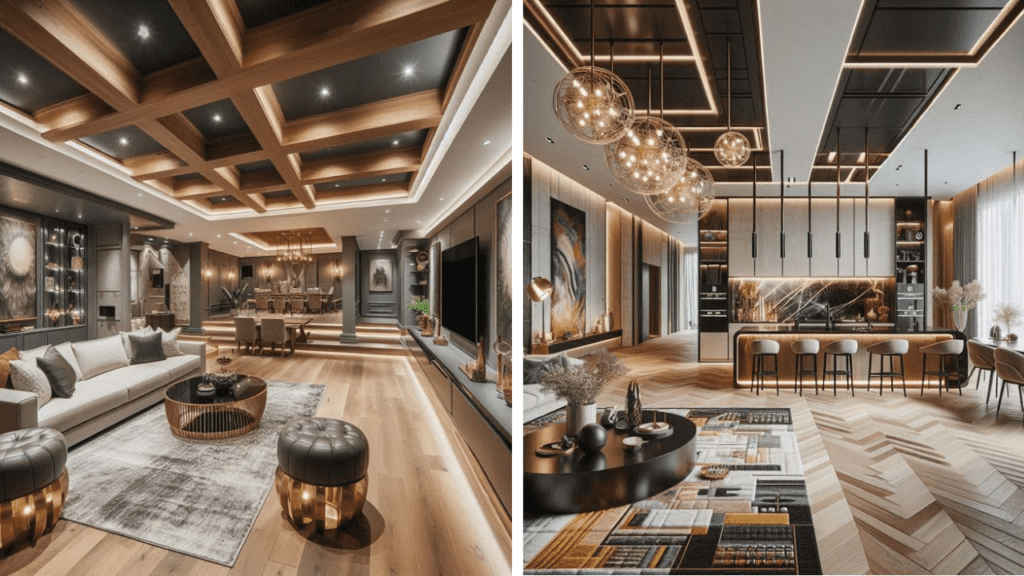
The coffered ceilings, which are composed of a framework of sunken panels, are creeping back into the domestic interior design practice. Coffered ceilings emerged in classical architecture however they are now been seen through modernized lenses. They all enhance the room internally by adding more height and elaboration to the decor making the room comfortable and expensive.
- Material: There are some changes also in modern coffered ceiling design which may include the combination of such structural elements composed of timber, gypsum, and metal. The material selection can be very beautifying as it determines the overall feel, whether it is conventional or country, contemporary or even gumption.
- Lighting Integration: Light fixtures and recesses installed within coffered ceilings lend themselves beautifully to the design, as with the enhanced depth, the coffer appears to emanate a soft warm light. Light effects can be added within the coffers using LED strips, recessed lights, or chandeliers
.2.2 Exposed Beams
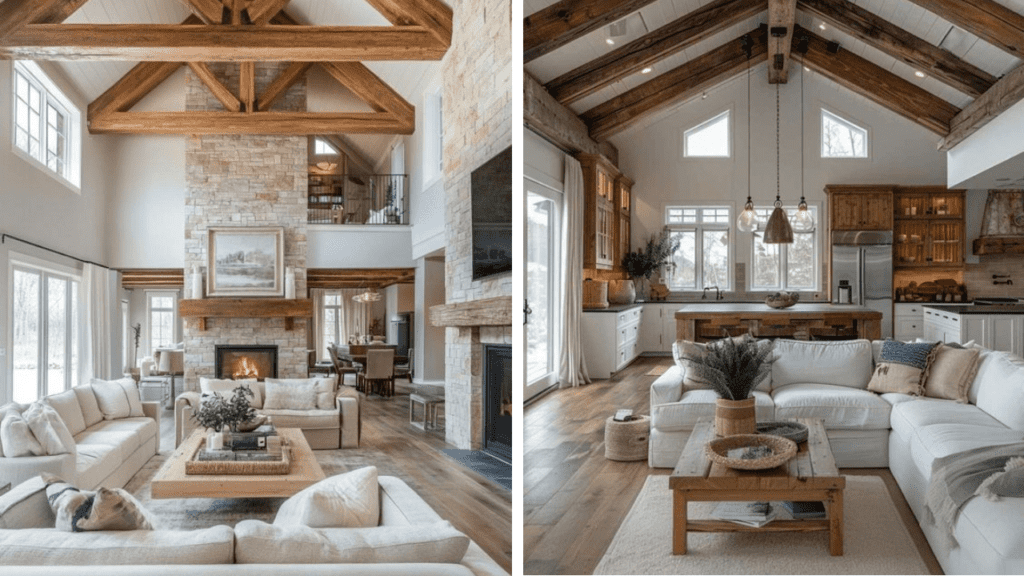
The use of beams in ceilings is done to achieve unfinished or designer industrial styles in the room. This design movement focuses on the building materials and the frame of the room wherein the highly decorative elements combine ancient and modern features.
- Wooden Beams: Wooden beams look most attractive when a warm rustic feel is desired since this is the most natural building component. They are suitable for all styles, traditional and modern as the grain and overall look of timber varies.
- Metal Beams: If there is a need for an industrial or a minimalistic approach, metal beams can be used. They can or cannot be painted and so are very good at making ceilings look rugged and cool.
- Faux Beams: If such structural members are not available for poles or any other systems, faux beams made from fiberglass or similar modeling material can be used. These beams look like real ones, but this time they do not weigh as the log ones do nor do their price.
2.3 Tray Ceilings

Tray ceilings are also common in contemporary ceiling design and are referred to as recessed ceilings. Tray ceilings are lowered around the periphery and have a section at the center which rises above. Tray ceilings help to create vertical space and a sense of volume in the room.
- Customization: Other than that, tray ceilings are often enhanced with various design features like crown molding, paint accents, or wallpapering. This is especially true in the case of remodeling when ceilings have the potential to become a design element in one or a few rooms of the house.
- Lighting Effects: Built-up ed ceilings accommodate various means of sub-lighting such as LED systems embedded around the wall perimeter. This lighting technique gives off low, light temperatures that create an atmosphere in the room without being too much.
2.4 Stretch Ceilings
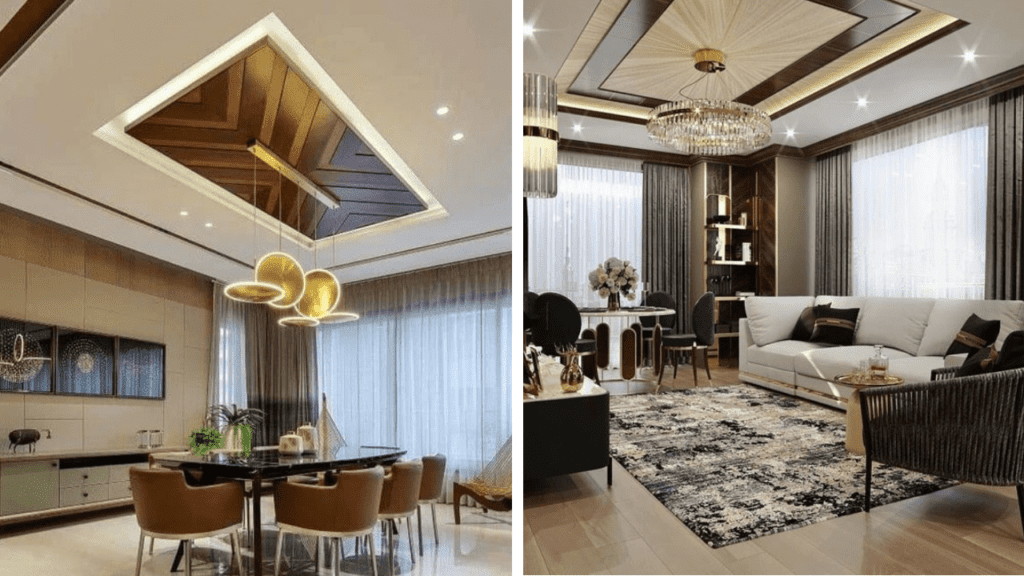
Stretch ceilings are an up-to-date and creative method of finishing a room and are limited only by the imagination of the user. A stretched ceiling is devised as a suspension decoration system, which by definition consists of a lightweight canvas or membrane stretched over a frameset ceiling. This kind of ceiling allows perfect flat ceilings and other shapes that curve.
- Material Variety: The available range of stretch ceilings is huge and includes materials like PVC stretch ceilings, fabric, polyester, etc. Custom-designed stretching ceilings can be covered with fabric on all walls or floors and other patterns or images can be applied too.
- Lighting Integration: Stretch ceilings can be integrated with light fixtures, such as LED lights, mounted within the panel or other lighting sources, thus enhancing the room with a dainty yet compact glowing feature. This is mostly applicable in commercial environments such as restaurants, hotels, retail shops, and many more.
2.5 Wood Panel Ceilings
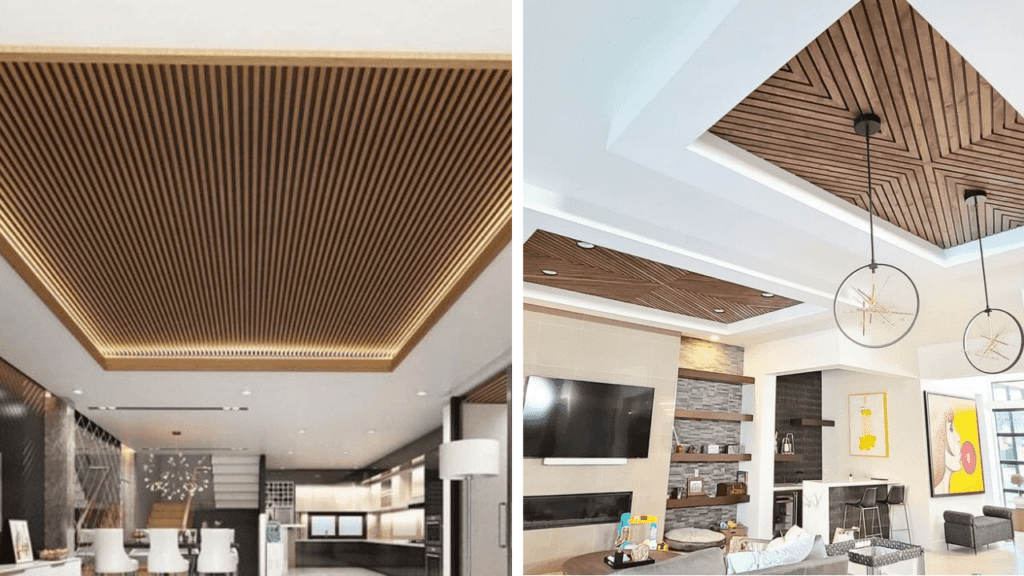
Wood panel ceilings add warmth and texture and are a natural feature in the inside of a building. In a residential setting, this is a trend more so loved in designing where one would want a warm friendly environment.
- Wood Panel Ceilings: Panel ceilings can be made of different wood such as pine and oak, and faced with finishes that include walnut and cedar, among others. The type of wood and the finish used can also range from light to dark than it already is.
- Design Flexibility: Wood ceiling panels can be laid out in various directions with the most common being horizontal, vertical, and diagonal depending on the intention. They can also give way to mixed-use spanning other materials incorporation for instance metal or glass offering a fore more trendy technique.
2.6 Suspended Ceilings
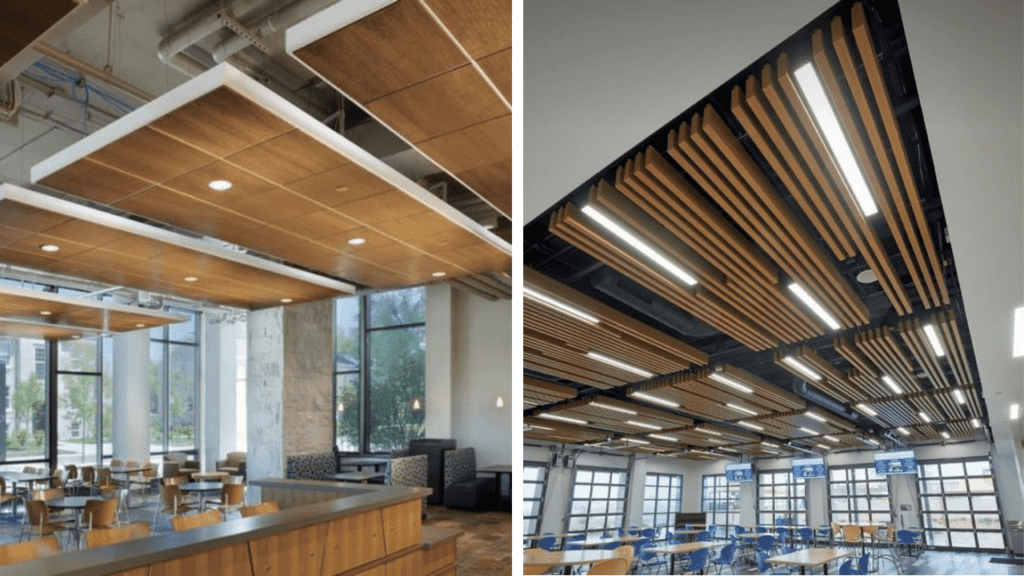
Suspended ceilings are also referred to as drop ceilings. This is a ceiling type that combines functionality with effects in a modern design. This ceiling construction system consists of a framework, and grid, in which is embedded lightweight covering material, which is removable or exchangeable easily.
- Acoustic Benefits: Commercial places usually adopt the use of suspended ceilings because these provide a good deal of soundproofing thereby enhancing the comfort of occupants by lowering noise levels.
- Design Options: The recent designs of the suspended ceilings have exceptional accessories like the accessory’s outlook in colors and patterns accommodating levels of divergence. Apart from that they can also act as covers for wiring, plumbing, and HVAC systems leaving behind a neat appearance.
2.7 Vaulted Ceilings
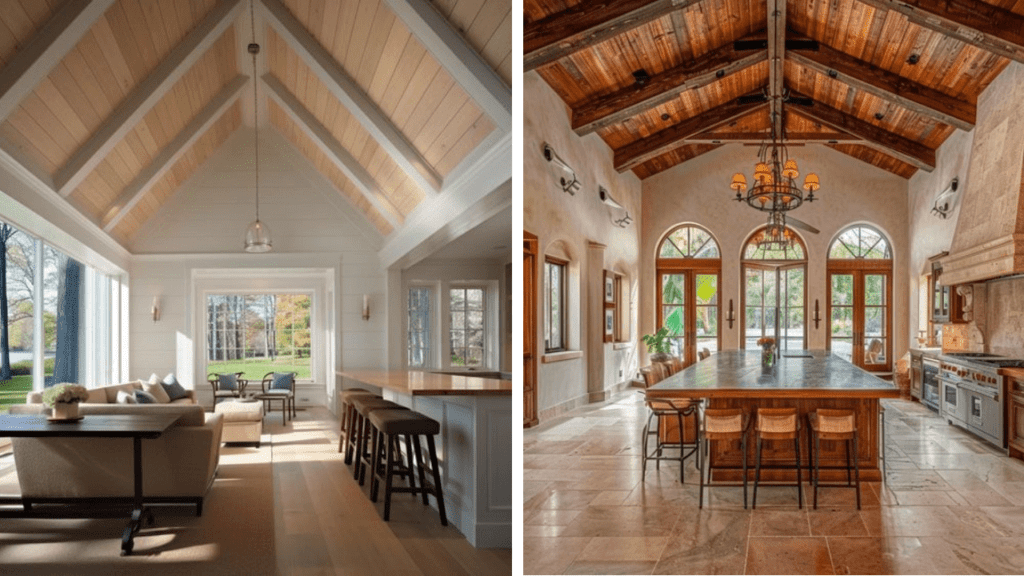
Vaulted ceilings are an elegant feature of enhancement to spaces that can be quite useful to other furniture maybe by making spaces feel larger and more airy. This type of ceiling is composed of high ornamental rest which has a complementing arch, therefore rendering the room appealing.
- Design Styles: Depending on the tastes of the owners, vaulted ceilings can complement almost any design style, be it classical, country, modernist, or even minimalistic. Including exposed beams, skylights, or large windows can further enhance the impact of a vaulted ceiling.
- Energy Efficiency: On the other hand, vaulted ceilings create the feeling of spaciousness within a room; they may also lead to higher energy costs since there is a large area that must be heated or cooled for comfort. Other precautions that can be undertaken include fixing the ceiling and installing cooling, heating and lighting equipment which are energy efficient.
2.8 Popcorn Ceilings
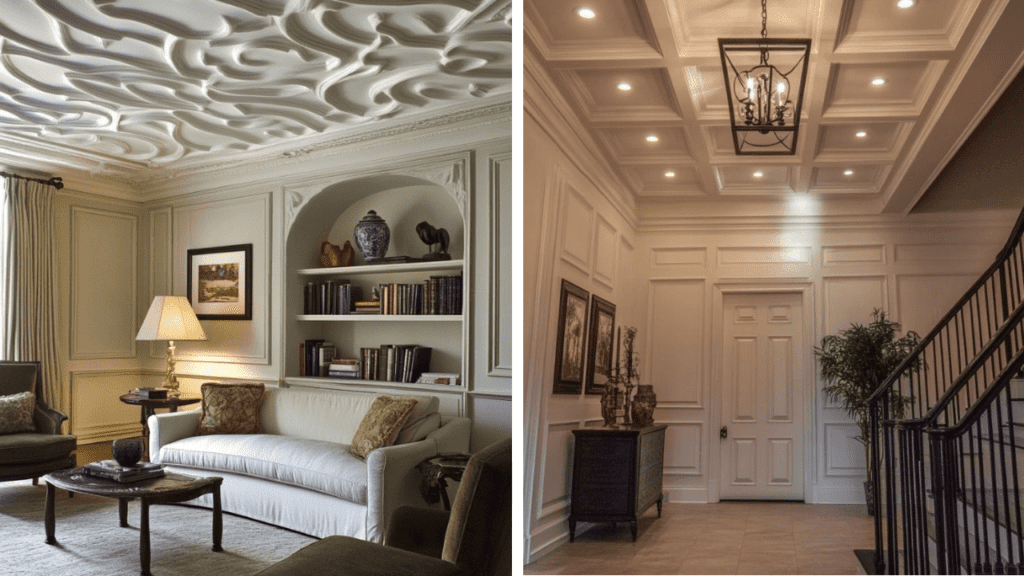
Popcorn or stipple acoustic ceilings as they are popularly known, were very common applications in homes built in the middle of the 20th century due to that quality. They have however grown less and less accepted by modern society, where very few people can be found preferring such ceilings over a more sleek contemporary finish.
- Deconstruction and Reconstruction: A popcorn ceiling should not be repaired as it is hard to repair. If it contains asbestos, one should cover it with a safer and modern material.
- Modern Alternatives: In cases where individuals prefer the texture of popcorn ceilings, but would like to feel free to implement a modern design, it is recommended to employ knockdown texture, orange peel texture or even wallpaper.
2.9 Ceiling Tiles and Panels

Ceiling tiles and panels offer a flexible solution for the creation of classical and non-classical ceilings. A wide variety of materials, patterns, and colors let one’s imagination run wild in the design.
- Materials: Ceiling tiles and panels can consist of different materials such as metals, wood, and synthetic materials like PVC, and GYPSUM. Each of the materials has its own pros including durability, acoustic insulation, or even easier structure setup.
- Design Flexibility: Different shapes and arrangements such as herringbone, checkerboard, or diagonal are used to facilitate the creation of various patterns. They can be designed to frame particular areas of the room for instance, above the dining table or at the front door.
2.10 Green Ceilings
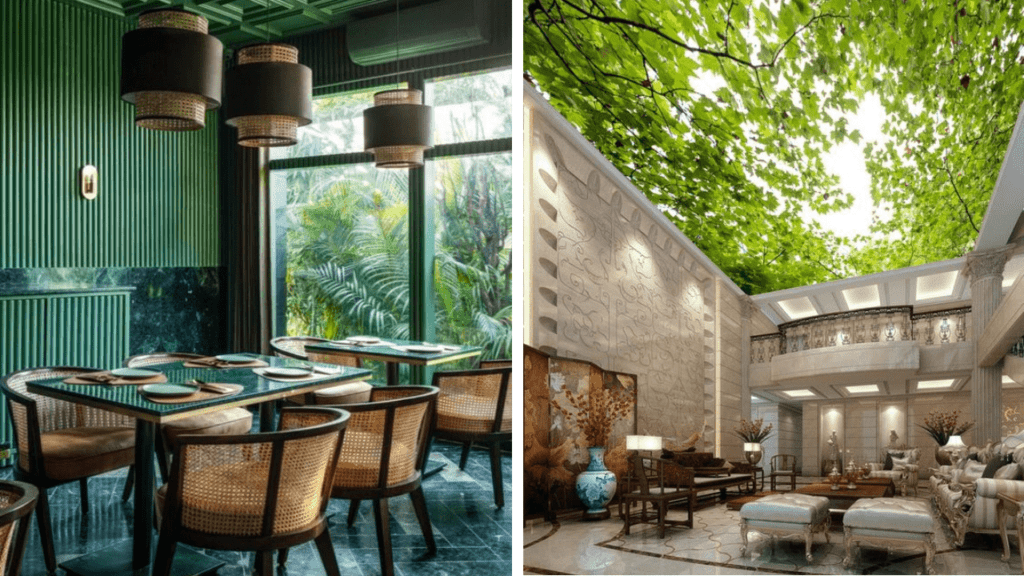
Living or green ceilings are for example considered as an advanced environmental trend because it uses green vegetation and/or green plants in the ceiling design. The ceiling enriches the architectural space enhances the quality of the room air and contributes to one’s health.
- Plant Selection: Green ceilings require a careful choice of plants. This depends on light, humidity, and maintenance. These are some of the very popular.
- Installation and Maintenance: The installation of a green ceiling involves a lot of planning as well as the incorporation of specific systems that can support the plants and water them properly. All these help in ensuring that the ceiling remains green and healthy and does not lose its charm.
3. Choosing the Right Ceiling Design for Your Space
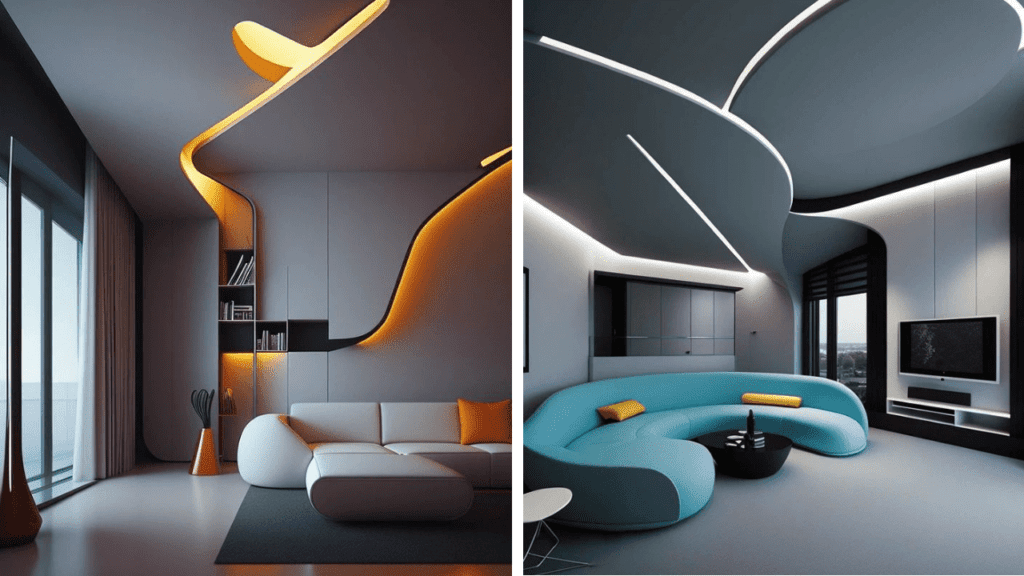
3.1 Consider the Room’s Function
The function of the room is crucial when selecting the appropriate ceiling design. For example, within a coffered ceiling there may fit a more elegant living or dining room, while a stretch ceiling with built-in illumination may suit a contemporary chef’s or a wet room instead. Keep in mind how the ceiling shape will serve the function of the room and add to its usefulness.
3.2 Evaluate the Room’s Size and Height
This feature of the room including its size and height is also of utmost importance when choosing a ceiling design. More extravagant designs such as vaults or suspended or coffering techniques can be employed with high ceilings while low ceilings may use tray or dropped ceilings to add spaciousness.
3.3 Match the Overall Design Style
The design of the ceiling is also dependent on the design style employed within the space. For example, a rustic wood panel ceiling will work in an ironing board-styled house without any effort, whereas, the stretch ceiling will only find comfort in places far away from farmhouse minimalism or contemporary settings. Looking at the other parts of the room and the intended colors, materials, and texture will dictate the kind of design ceiling one should settle for.
3.4 Consider Lighting Options
Light is an important element that determines the design of the ceiling. Proper light can also add to the visual impact of this structural component and focus attention on certain architectural elements or set the appropriate mood. Think about how many ways of illumination there are including recess lighting, chandeliers, or LED strips, which can be integrated into the ceiling design to achieve the desired effect.
3.5 Budget and Maintenance
Last but not least, let’s focus on budget and maintenance issues regarding the implementation of a particular ceiling design. In some cases, for instance, when using coffered or green ceiling designs, a person will need to spend a lot of money on capital expenses and even today’s maintenance. Conversely, in the case of designs that are not so aesthetically appealing such as suspended ceilings and tray ceilings, the construction and maintenance will be somehow less expensive.
4. Conclusion
To conclude this chapter in an orderly manner, let’s pay more attention to the budget and, if necessary, maintenance aspects of the realization of a particular ceiling design. In some images, such as coffered or green ceiling designs, buying a capital expense and even today’s maintenance would be very hard on the person. But in the case of this kind of designs, such as regional ceilings and tray ceilings which are not so pleasing to the eye, the construction and maintenance will be somewhat cheap.


